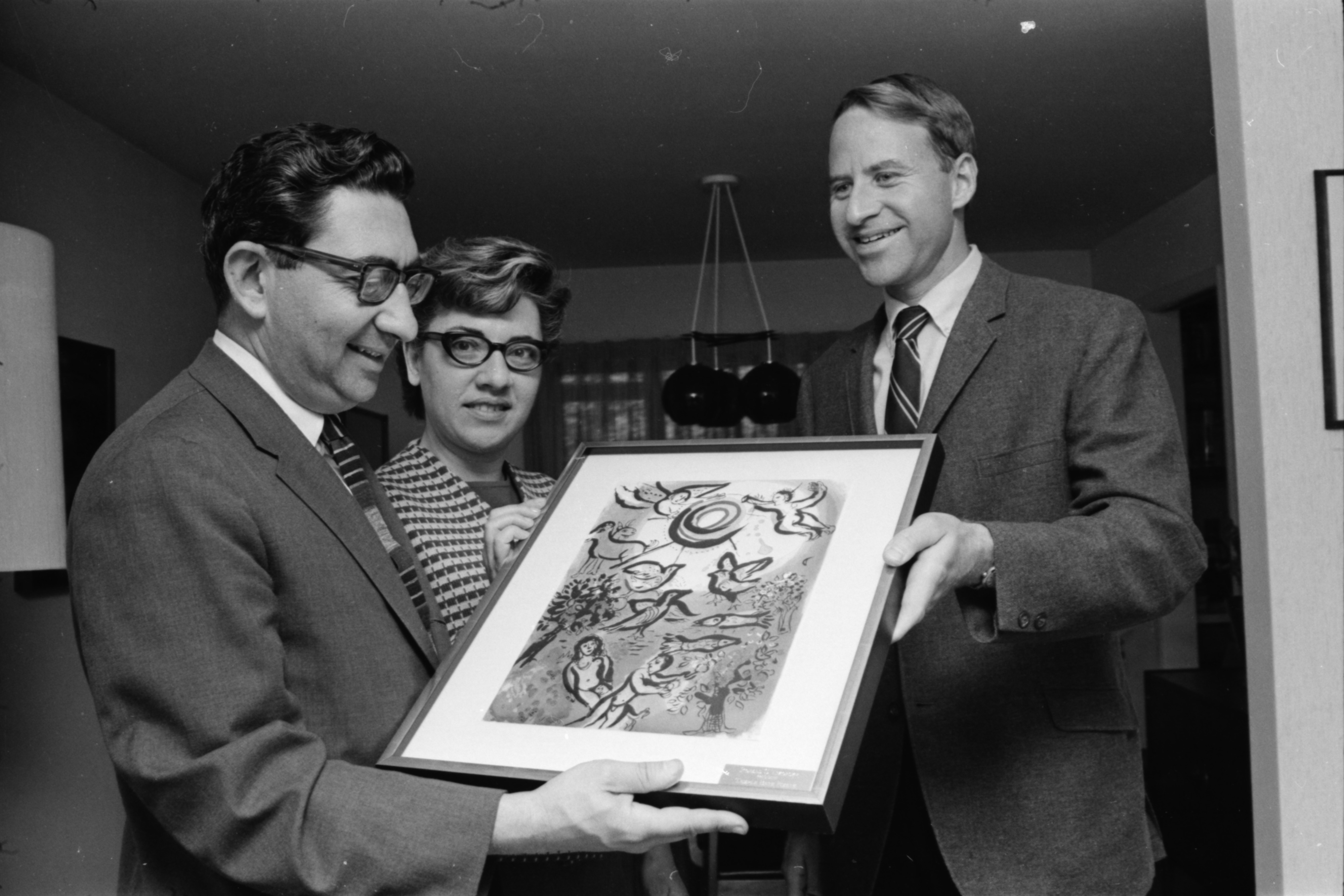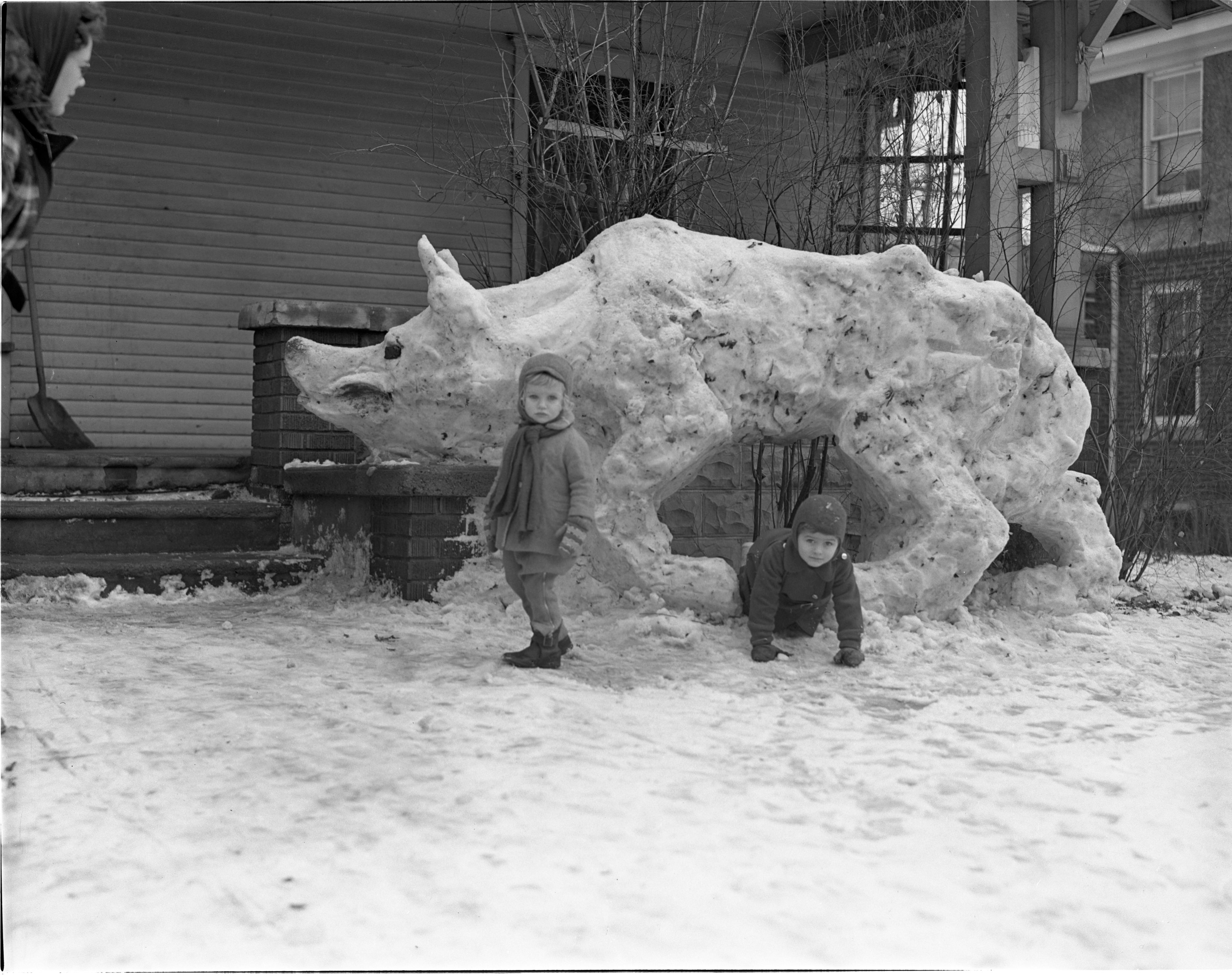Charles Irvin Of U-M Dies At Petoskey

Parent Issue
Day
2
Month
August
Year
1956
Copyright
Copyright Protected
- Read more about Charles Irvin Of U-M Dies At Petoskey
- Log in or register to post comments
Virginia Hendrickson Irvin, miniature painter, dead

Parent Issue
Day
8
Month
January
Year
1992
Copyright
Copyright Protected
- Read more about Virginia Hendrickson Irvin, miniature painter, dead
- Log in or register to post comments
Prof. & Mrs. Ronald Tikofsky Receive A Lithograph From Temple Beth Emeth, April 1969

Year:
1969
Published In:
Ann Arbor News, May 3, 1969
Caption:
Allyn D. Kantor (right), newly elected president of Temple Beth Emeth (Reform), presents a lithograph by Marc Chagall entitled, "Creation," to Prof. and Mrs. Ronald S. Tikofsky in appreciation of their contributions to the Beth Emeth congregation. Prof. Tikofsky was the congregation's first president and also served as chairman of its founding steering committee. He is a professor of psychology at the U-M.
Ann Arbor News, May 3, 1969
Caption:
Allyn D. Kantor (right), newly elected president of Temple Beth Emeth (Reform), presents a lithograph by Marc Chagall entitled, "Creation," to Prof. and Mrs. Ronald S. Tikofsky in appreciation of their contributions to the Beth Emeth congregation. Prof. Tikofsky was the congregation's first president and also served as chairman of its founding steering committee. He is a professor of psychology at the U-M.
Copyright
Copyright Protected
Grant & David With Snow Wolf Sculpted By Their Father, Avard Fairbanks, January 1940

Year:
1940
Published In:
Ann Arbor News, January 13, 1940
Caption:
The thawing weather in the last two days prompted numerous youngsters - and oldsters, too - to build snowmen in Ann Arbor. Above is shown a "wolf at the door" of the home of Prof. Avard Fairbanks, sculptor, which he made to entertain his children. Standing beside the snow wolf are two of the children of Prof. and Mrs. Fairbanks, Grant (left), who is two years old, and David (right), who is three. Prof. Fairbanks received some help in making the wolf from his children.
Ann Arbor News, January 13, 1940
Caption:
The thawing weather in the last two days prompted numerous youngsters - and oldsters, too - to build snowmen in Ann Arbor. Above is shown a "wolf at the door" of the home of Prof. Avard Fairbanks, sculptor, which he made to entertain his children. Standing beside the snow wolf are two of the children of Prof. and Mrs. Fairbanks, Grant (left), who is two years old, and David (right), who is three. Prof. Fairbanks received some help in making the wolf from his children.
Copyright
Copyright Protected
U of M Professor Ann Marie Sastry Explores Sea Urchins With Clague Middle School Students, September 2000 Photographer: Robert Chase

Year:
2000
Published In:
Ann Arbor News, October 2, 2000
Caption:
University of Michigan professor Ann Marie Sastry shows Clague Middle School seventh-graders the feet of a sea urchin as part of a program promoting science and engineering. The students are, from left, Bryan Schultz, Iman Maiza and Corey Blair.
Ann Arbor News, October 2, 2000
Caption:
University of Michigan professor Ann Marie Sastry shows Clague Middle School seventh-graders the feet of a sea urchin as part of a program promoting science and engineering. The students are, from left, Bryan Schultz, Iman Maiza and Corey Blair.
Copyright
Copyright Protected
Prof. Pawlowski Dies In France

Parent Issue
Day
8
Month
March
Year
1951
Copyright
Copyright Protected
- Read more about Prof. Pawlowski Dies In France
- Log in or register to post comments
Dr. James E. Harris With Portable X-Ray Machine, March 1967 Photographer: Doug Fulton

Year:
1967
Published In:
Ann Arbor News, March 10, 1967
Caption:
Dr. James E. Harris, U-M professor of dentistry, adjusts portable X-ray machine which made possible the first X-rays of the pharaohs who ruled Egypt more than 3,000 years ago. The machine operates on radioactive ytterbium-169 supplied by the U-M Phoenix (atoms-for-peace) Project from its Ford Nuclear Reactor.
Ann Arbor News, March 10, 1967
Caption:
Dr. James E. Harris, U-M professor of dentistry, adjusts portable X-ray machine which made possible the first X-rays of the pharaohs who ruled Egypt more than 3,000 years ago. The machine operates on radioactive ytterbium-169 supplied by the U-M Phoenix (atoms-for-peace) Project from its Ford Nuclear Reactor.
Copyright
Copyright Protected
New 'U' X-Ray Machine Set For Nile Project

Parent Issue
Day
3
Month
March
Year
1965
Copyright
Copyright Protected
- Read more about New 'U' X-Ray Machine Set For Nile Project
- Log in or register to post comments
'U' Nile Study Meets Unusual Woes

Parent Issue
Day
7
Month
March
Year
1966
Copyright
Copyright Protected
- Read more about 'U' Nile Study Meets Unusual Woes
- Log in or register to post comments
Egypt Getting X-Rays Of Mummies

Parent Issue
Day
6
Month
January
Year
1968
Copyright
Copyright Protected
- Read more about Egypt Getting X-Rays Of Mummies
- Log in or register to post comments